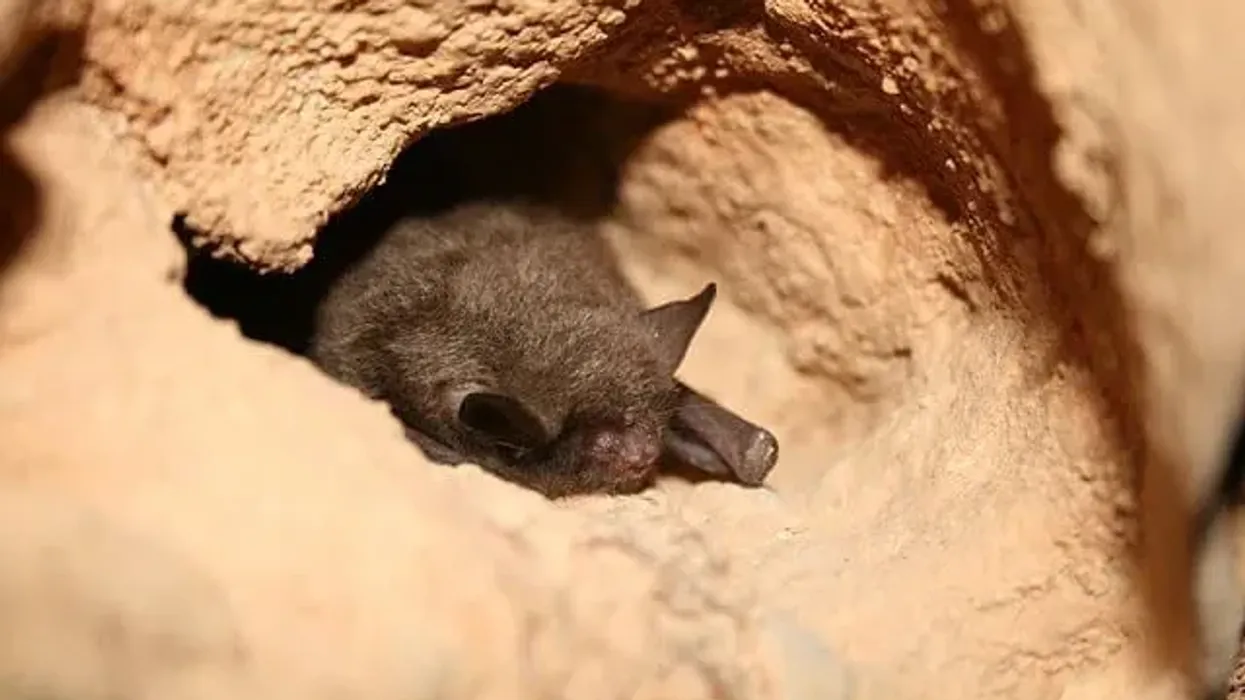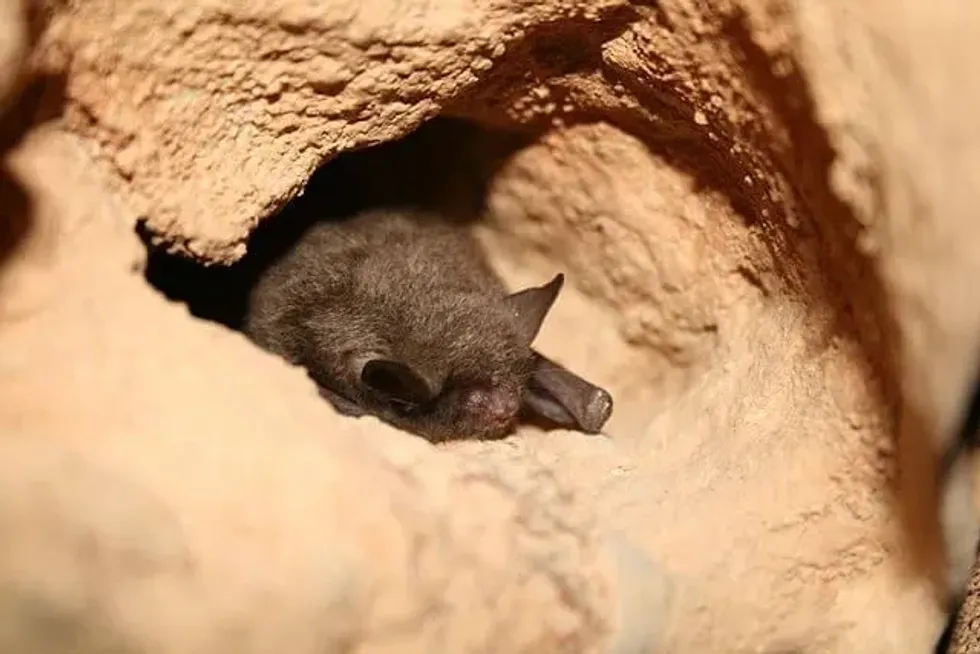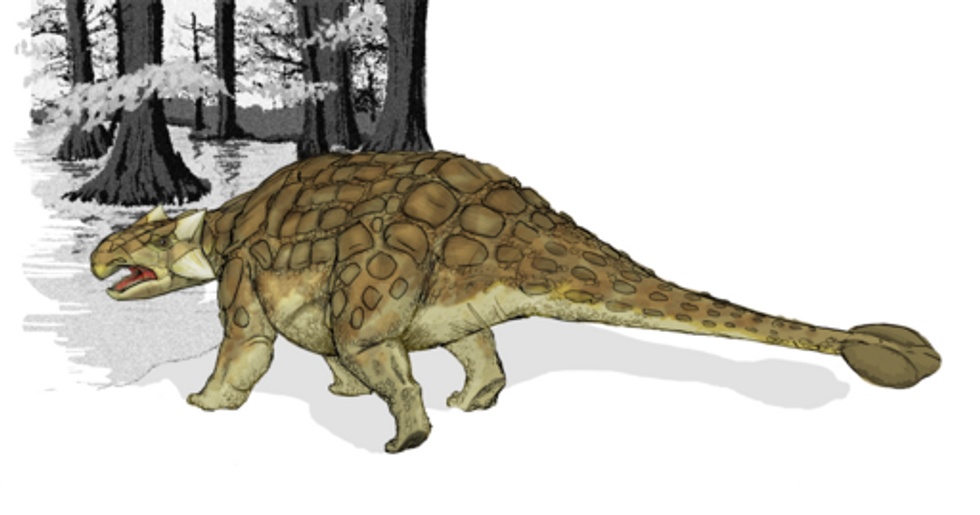A mouse-eared bat or Myotis genus species, the Indiana bat (scientific name Myotis sodalis), is native to North America. These bats are found in several states of the United States such as New York, Massachusetts, New Hampshire, Vermont, Virginia, and North Carolina. Both winter hibernation sites and summer habitats are included in these states.
These medium-sized bats are found in gray, black, and chestnut color, while their average weight and length are 0.18-0.39 oz (5-11 g) and 2.7-3.5 in (7-9 cm), respectively. Unlike other bats, Indiana bats possess pink lips. The species resemble the little brown bat, however, these bats possess soft fur.
The species primarily dwells in hardwoods and hardwood-pine forests, but mainly hibernates in limestone caves. In the summer season, this bat roosts under the bark of trees and bridges. The Indiana bat is an insectivore and mainly preys on beetles, flies, bees, wasps, and moths.
The International Union for Conservation of Nature listed the species in the Near Threatened category, while the U.S Fish and Wildlife Service listed the Indiana bat as an Endangered species. Studies reveal that there was a decline of over 50% in the Indiana bat population in the past decade.
Loss of habitat, diseases such as white-nose syndrome, and predation are a few major threats to the species. While talking about the Indiana bat recovery plan, the respective governments have banned cave entry.
Let's read more interesting facts about the Indiana bat and if you found this article insightful, don't forget to check out exciting information about different animals like the wombat and the greater mouse-eared bat.
Indiana Bat Interesting Facts
What type of animal is an Indiana bat?
The Indiana bat (Myotis sodalis) is a bat that possesses mouse-like ears and pink lips, unlike other species. The bat is an insectivore and feeds on beetles, moths, bees, wasps, flies, and several other flying insects.
What class of animal does an Indiana bat belong to?
The Indiana bat (Myotis sodalis) belongs to the class of Mammalia, the family of Vespertilionidae, and the Myotis genus. The species of the Myotis genus are also known as mouse-eared bats.
How many Indiana bats are there in the world?
Several factors are affecting the Indiana bat populations very badly. Unlike most bats, Indiana bats spend most of their time in the eastern United States and spend the rest of their time hibernating.
Since the '70s, a continuous decline can be noticed in the bat populations. A study carried out in 1985 on these hibernating bats reveals that the numbers were about 244,000. Also, recent research reveals that there was a decline of more than 50% in the Indiana bat population in the past decade.
Where does an Indiana bat live?
The Indiana bat (Myotis sodalis) is endemic to North America and one can find the species in several states of the United States such as New York, Massachusetts, New Hampshire, Vermont, Virginia, and North Carolina. Both winter hibernation sites and the summer habitat are included in these states.
While talking about the Indiana bat migration, this bat moves to the north in the spring season and roosts in tree cavities.
What is an Indiana bat's habitat?
While talking about the Indiana bat habitat, the species primarily dwells in hardwoods and hardwood-pine forests, but mainly hibernates in limestone caves. In the summer months, Indiana bats roost under the bark of dead trees and bridges.
They generally change their habitat according to seasons. The summer season occurs from October to November and the temperature remains cool from March to April. Also, the Indiana bat range generally varies according to seasons.
The average home range in the fall months is around 1545 ac (625 ha). They usually do not defend their home range but do protect their maternity colonies.
Who do Indiana bats live with?
Like other species of bats, Indiana bats are social animals and prefer to live in large groups or colonies. Males and females hibernate together but separate in the warmer months. Indiana bats primarily form maternity colonies that consist of females and juveniles.
How long does an Indiana bat live?
The average lifespan of Indiana bats is around 15 years in the wild, while they can live up to 20 years in captivity if given proper care.
How do they reproduce?
Like other species, the Indiana bat (Myotis sodalis) follows the polygynous mating pattern in which the male bat mates with several females in mating season. Males generally stay near hibernacula waiting for un-mated females. Copulation primarily takes place in late October or the fall season, but they even mate in winter or late spring on rare occasions.
Right after mating, Indiana bats enter into hibernation and females generally delay the fertilization by storing the sperm throughout the winter season. The gestation period lasts for more than two months and females give birth mainly in the summer season.
Females give birth to around one to two pups or babies in late June and early July. Only females look after their pups at roosting sites and the weaning period generally lasts for one month.
Pups usually leave the maternity colony after two to three months. Also, female bats generally gather in large groups under the loose bark of trees for their pups.
What is their conservation status?
The International Union for Conservation of Nature listed the species in the Near Threatened category, while the U.S Fish and Wildlife Service listed the Indiana bat as an Endangered species. Studies reveal that there was a decline of more than 50% in the Indiana bat population in the past decade.
Humans, loss of habitat, diseases such as white-nose syndrome, and predation are a few major threats to the species. While talking about the Indiana bat recovery plan, hibernacula entry has been banned by the respective governments.
Indiana Bat Fun Facts
What do Indiana bats look like?
These medium-sized bats are found in gray, black, and chestnut colors. The keeled calcar and small cartilage projecting from the feet provide stability to the wings. The Indiana bat appearance almost resembles the little brown bat but the length of toe hairs and pink lips help to differentiate.
How cute are they?
These medium-sized Indiana bats are extremely cute and the most alluring thing about these bats are their mouse-like ears. If they had no wings, humans would have surely confused them with rats. Also, one would love to watch large colonies of Indiana bats at hibernation sites.
How do they communicate?
Like other species, Indiana bats use similar methods to communicate. They use echolocation to find their colony members and habitat. The Indiana bat species is known for its developed eye sight that helps them to travel from winter hibernacula to summer habitat. In the breeding season, chemical cues are used to communicate with each other.
How big is an Indiana bat?
Indiana bats average weight and length are 0.18-0.39 oz (5-11 g) and 2.7-3.5 in (7-9 cm), respectively. These bats are quite bigger than hoary bats and red bats.
How fast can an Indiana bat fly?
The exact speed of these hibernating bats is not known, but they are quite agile in flight during the night. The quick movements of these bats help them to avoid predation. Also, it was observed that Indiana bats move in elliptical patterns among trees. They travel long distances from winter hibernacula to summer roosts.
How much does an Indiana bat weigh?
The average weight of Indiana bats is 0.18-0.39 oz (5-11 g).
What are the male and female names of the species?
There are no specific names given to the male and female Indiana bats. Female bats are generally a bit larger than male bats. Also, only females provide parental care to the pups.
What would you call a baby Indiana bat?
Generally, the term pup is used to refer to an Indiana bat baby. The baby becomes fully independent two to three months after birth.
What do they eat?
Like most species of bats, the species is an insectivore and the Indiana bat diet primarily includes prey such as beetles, flies, bees, wasps, moths, grasshoppers, and several other flying insects. Indiana bats are often preyed upon by snakes, owls, and raccoons. Also, in the winter season, it becomes quite difficult for their predators to attack the hibernacula sites.
Are they dangerous?
Generally, these hibernating bats are nocturnal and prefer to live away from human settlements. They do not pose any threat or danger to humans unless someone tries to provoke or threaten them.
Also, males are quite territorial, while the females of maternity colonies are very protective of the pups and can turn quite aggressive. It is always advised not to harm the Endangered species of Indiana bats as humans have been known to destroy their sites and kill them.
Would they make a good pet?
It is not legal to keep Indiana bats as pets as several organizations such as the IUCN, U.S Fish and Wildlife Service, and Michigan Natural Features Inventory have listed the species in either the Near Threatened or the Endangered category.
It is not possible for them to survive in human-made habitats as these bats hibernate in winter and require proper shelters. Also, they turn very aggressive in aviaries and sometimes die.
Instead of keeping them in captivity, one should take steps for Indiana bat conservation and promote their natural habitats.
Did you know...
The big brown, red, and little brown bats are common in Indiana. These bats hibernate like Indiana bats.
Indiana bats help to control the population of pests.
The maternity colony of gray bats consists of more than 100,000 individuals and roost in the winter in caves that are vertical and deep.
Do Indiana bats bite?
Indiana bats are insectivores and they generally do not bite humans unless threatened or provoked them. These animals are known for carrying rabies (a virus that could cause death) and if these bats scratch or bite someone, the person should consult the doctor immediately.
How does the Indiana bat protect itself?
Very little information about how these bats protect themselves from diseases and humans is available as of now. These bats generally hibernate in winters and humans are known for invading the roost sites.
A study revealed that more than 90% of Indiana bats die during hibernation. Also, they are prone to a rare fungal disease known as the white-nose syndrome. Bat-friendly gates keep humans away from their roost sites.
Is it illegal to kill bats in Indiana?
Yes, it is illegal to kill Indiana bats as the population throughout their range is declining rapidly. Also, the current status of the species is not satisfying.
Here at Kidadl, we have carefully created lots of interesting family-friendly animal facts for everyone to discover! Learn more about some other mammals from our ghost bat facts and megabat facts pages.
You can even occupy yourself at home by coloring in one of our free printable Indiana bat coloring pages.










